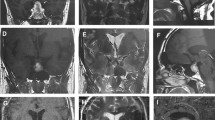Abstract
Successful therapy for pituitary apoplexy depends on prompt recognition of the clinical syndrome, accurate anatomic evaluation of the lesion with the CT scan, intensive steroid replacement therapy, and effective transphenoidal decompression of the tumor. Successful long-term management of patients who have suffered pituitary apoplexy requires recognition by the complex interrelationships of the pituitary with adrenal, thyroid, gonadal, pancreatic, and gut physiology. Such patients often require multiple medications for replacement therapy. Surgical treatment is often supplemented with radiation therapy, and prolactin- and growth hormone-secreting adenomas may require long-term management with bromocriptine. Careful follow-up evaluations and appropriate post-surgical therapy enable most of these patients to live normal lives.
Résumé
Le succès du traitement de l'apoplexie de l'hypophyse est fonction de la précocité du diagnostic de l'affection, de l'appréciation anatomique exacte de la lésion à l'aide de la tomodensitométrie, de l'efficacité du traitement stéroïdien et de la décompression transphénoïdale adéquate.
Le traitement ultérieur à long terme nécessite de préciser les relations complexes existant entre l'hypophyse et les surrénales, la thyroïde, les gonades, le pancréas, les hormones digestives. Très souvent de multiples médications compensatoires sont nécessaires.
Le traitement chirurgical est souvent complété par l'irradiation cependant que les adénomes à prolactine et à hormone de croissance nécessitent un traitement prolongé à l'aide de la bromocriptine. Le fait de suivre avec attention ces malades atteints d'une telle affection et de les soumettre à un traitement médical post opératoire adéquat leur permet de mener une vie normale.
Similar content being viewed by others
References
Conomy, J.P., Ferguson, J.H., Brodkey, J.S., Mitsumoto, H.: Spontaneous infarction in pituitary tumors: Neurologic and therapeutic aspects. Neurology (NY)25:580, 1975
Post, M.J.D., David, N.J., Glaser, J.S., Safran, A.: Pituitary apoplexy in clinical perspective. In Neuroophthalmology, vol. 8, J.S. Glaser, J.L. Smith, eds., St. Louis, C.V. Mosby, 1975, pp. 140–165
Rovit, R.L., Fein, J.M.: Pituitary apoplexy: A review and reappraisal. J. Neurosurg.37:280, 1972
Uihlein, A., Balfour, W.M., Donovan, P.F.: Acute hemorrhage into pituitary adenomas. J. Neurosurg.14:140, 1957
Uihlein, A.: Acute visual failure as a neurosurgical emergency. J. Neurol. Neurosurg. Psychiat.20:231, 1957
Zervas, N.T., Mendelson, G.: Treatment of acute haemorrhage of pituitary tumors. Lancet1:604, 1975
Rosenbaum, T.J., Houser, O.W., Laws, E.R., Jr.: Pituitary apoplexy producing internal carotid artery occlusion. J. Neurosurg.47:599, 1977
Author information
Authors and Affiliations
Rights and permissions
About this article
Cite this article
Laws, E.R., Ebersold, M.J. Pituitary apoplexy—An endocrine emergency. World J. Surg. 6, 686–688 (1982). https://doi.org/10.1007/BF01655359
Issue Date:
DOI: https://doi.org/10.1007/BF01655359




